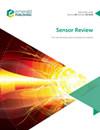用于深度检测的磁致伸缩触觉传感器的设计
IF 1.4
4区 工程技术
Q3 INSTRUMENTS & INSTRUMENTATION
引用次数: 1
摘要
目的设计一种用于表面深度检测的磁致伸缩触觉传感器。与人类手指不同,尽管大多数触觉传感器对压力具有高灵敏度,但它们无法精确检测物体表面的毫米级深度信息。为了提高表面深度信息的检测能力,本文开发了一种结合反磁致伸缩效应和仿生结构的压磁传感器。设计/方法/方法设计并研究了一种基于Galfenol[(Fe83Ga17)99.4B0.6]的磁致伸缩触觉传感器,用于表面深度测量。通过实验和理论确定了传感器的最佳结构。建立了静态和动态特性测试平台。对传感器的静态和动态传感性能进行了实验研究。查找传感器可以检测0–2 mm深度变化,灵敏度为91.5 mV/mm。50的分辨率 在深度方向上可以达到µm。在50个循环的加载和卸载测试中,传感器输出电压幅度的最大误差仅为2.23%。独创性/值传感器可以通过滑动运动以良好的重复性精确测量物体表面的深度信息,为物体表面形貌检测提供参考。本文章由计算机程序翻译,如有差异,请以英文原文为准。
Design of magnetostrictive tactile sensor for depth detection
Purpose
This paper aims to design a magnetostrictive tactile sensor for surface depth detection. Unlike the human finger, although most tactile sensors have high sensitivity to pressure, they cannot detect millimeter-level depth information on the surface of objects precisely. To enhance the ability to detect surface depth information, a piezomagnetic sensor combining inverse magnetostrictive effect and bionic structure is developed in this paper.
Design/methodology/approach
A magnetostrictive tactile sensor based on Galfenol [(Fe83Ga17)99.4B0.6] is designed and studied for surface depth measurement. The optimal structure of the sensor is determined by experiment and theory. The test platforms for static and dynamic characteristics are set up. The static and the dynamic sensing performance of the sensor are studied experimentally.
Findings
The sensor can detect 0–2 mm depth change with a sensitivity of 91.5 mV/mm. A resolution of 50 µm can be achieved in the depth direction. In 50 cycles of loading and unloading tests, the maximum error of the sensor output voltage amplitude is only 2.23%.
Originality/value
The sensor can measure the depth information of object surface precisely with good repeatability through sliding motion and provide reference for object surface topography detection.
求助全文
通过发布文献求助,成功后即可免费获取论文全文。
去求助
来源期刊

Sensor Review
工程技术-仪器仪表
CiteScore
3.40
自引率
6.20%
发文量
50
审稿时长
3.7 months
期刊介绍:
Sensor Review publishes peer reviewed state-of-the-art articles and specially commissioned technology reviews. Each issue of this multidisciplinary journal includes high quality original content covering all aspects of sensors and their applications, and reflecting the most interesting and strategically important research and development activities from around the world. Because of this, readers can stay at the very forefront of high technology sensor developments.
Emphasis is placed on detailed independent regular and review articles identifying the full range of sensors currently available for specific applications, as well as highlighting those areas of technology showing great potential for the future. The journal encourages authors to consider the practical and social implications of their articles.
All articles undergo a rigorous double-blind peer review process which involves an initial assessment of suitability of an article for the journal followed by sending it to, at least two reviewers in the field if deemed suitable.
Sensor Review’s coverage includes, but is not restricted to:
Mechanical sensors – position, displacement, proximity, velocity, acceleration, vibration, force, torque, pressure, and flow sensors
Electric and magnetic sensors – resistance, inductive, capacitive, piezoelectric, eddy-current, electromagnetic, photoelectric, and thermoelectric sensors
Temperature sensors, infrared sensors, humidity sensors
Optical, electro-optical and fibre-optic sensors and systems, photonic sensors
Biosensors, wearable and implantable sensors and systems, immunosensors
Gas and chemical sensors and systems, polymer sensors
Acoustic and ultrasonic sensors
Haptic sensors and devices
Smart and intelligent sensors and systems
Nanosensors, NEMS, MEMS, and BioMEMS
Quantum sensors
Sensor systems: sensor data fusion, signals, processing and interfacing, signal conditioning.
 求助内容:
求助内容: 应助结果提醒方式:
应助结果提醒方式:


